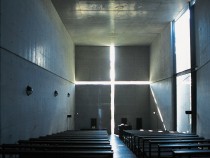
© Christian Schittich
When Tadao Ando completed his Church of Light in the late 1980s in Ibaraki, Japan seemed a lot farther away than now. Globalization had not yet reached its current scale, low-budget air travel wasn’t yet as widespread, and an airline ticket from Frankfurt to Tokyo cost four times in current monetary value. At the same time, the country had reached the end of its speculative economic bubble that continuously increased the value of the Yen, making Japan incredibly expensive for foreigners. Whoever happened to arrive there as an individual tourist usually had a particular reason. Visitors most likely either met travellers who were enthusiasts of Far-Eastern martial arts, or those inspired by Buddhist religion, and occasionally the select few interested in architecture. However, the latter were less attracted by the recent styles that currently appeal to so many student groups, but instead by the country’s brilliant traditional art of architecture. Back then, more and more often the name of one designer appeared in topical publications; one who began to attract interest in 1976 with a tiny residential house made of exposed concrete: Tadao Ando. (Christian Schittich)



